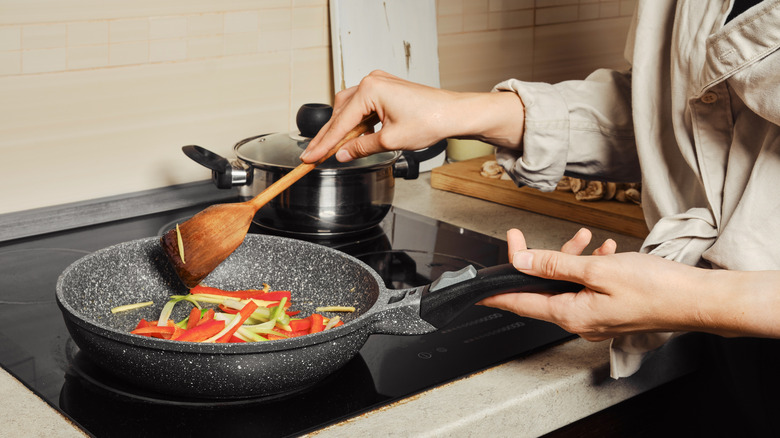Why You Should Use This Type Of Pan On Glass Cooktops
Glass stovetops are known for being sleek and relatively easy to clean (although there are some rules to keep in mind to keep them scuff-free); however, it's important to note that the type of pan you use will help ensure that it stays that way. Marissa Stevens, recipe developer and founder of Pinch and Swirl, said that you want to use pans with smooth bottoms that are "heavy enough to sit securely on the surface, but not so heavy that you could crack the glass if you accidentally bump or drop the pan." She said this is usually something like stainless steel or even "heavy-bottomed aluminum pans with stainless exteriors, as long as the base is truly flat."
When it comes to her favorite option, however, she reaches for a clad stainless steel pan (which just means that the bonded metal material is present throughout the pan, and not just applied to the bottom). "They don't warp and tend [to] have a smooth surface, so they offer stability with the fast, even-heating inner core of aluminum or copper and won't scratch the glass," Stevens said. Of course, you'll want to make sure you clean any burned food on your stainless steel pans properly. When it comes to the condition of the pan, Stevens recommended ensuring that it has a flat bottom without any sort of ridge or rough finish. You also want to make sure that you're careful about how you use the pan, noting that it's important to lower and lift it gently, and avoid dragging it across the glass. "That alone will save your glass cooktop a lot of wear."
What pans to avoid on glass cooktops
The first type of pan you'll want to avoid on a glass cooktop is any that has a warped bottom. "If it wobbles, it won't heat evenly," Marissa Stevens explained. She mentioned that you can easily check this by placing the pan on a flat surface and moving it back and forth. When it comes to materials, some certainly are best to be left for other cooktops. One such example is copper-bottomed pans. This is because they can leave permanent marks and discoloration on the glass, thanks to this particular metal and glass reacting with heat.
Cast iron pans can be a hit or miss (and Stevens specifically said that she'll only consider using one if it's enameled). "Cast iron holds heat really well, which is great for searing, but it's heavy and often has a rougher bottom surface," she noted. While she mentioned that she occasionally will use one if the recipe really calls for it, she's always careful about how she places it on the stovetop, and absolutely never slides it across the surface. While a positive is that enameled cookware comes in a variety of colors, if a recipe really calls for one, make sure to thoroughly clean and dry the bottom before using it to avoid any rough spots or old food particles. Other materials that are best to be avoided include stoneware and ceramics, as they're more susceptible to thermal shock than other types and could leave scuffs behind.


